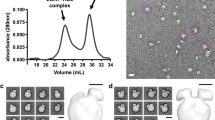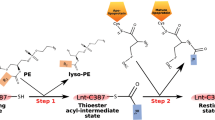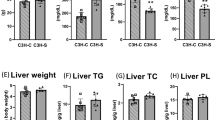Abstract
The transfer of insoluble cholesteryl esters among lipoprotein particles is a vital step in normal cholesterol homeostasis and may be involved in the development of atherosclerosis1. Extrahepatic tissues lack the enzymes required for the degradation of sterols to the excretable form of bile acids. Cholesterol synthesized in these tissues in excess of that needed for the synthesis of cell membranes or steroid hormones must accordingly be returned through the plasma to the liver for catabolism. The series of reactions involved has been termed reverse cholesterol transport1. Catalysed steps of this pathway are believed to include an efflux from peripheral cells, which generates a diffusion gradient between these membranes and extracellular fluid; esterification of this cholesterol by lecithin–cholesterol acyltransferase (LCAT) (phosphotidylcholine–sterol acyltransferase) acting on species of high-density lipoproteins; transfer of the cholesteryl esters formed (largely to low- and very low-density lipoproteins) (LDL and VLDL) by a cholesteryl ester transfer protein (CETP); and removal of these lipoproteins, together with their cholesteryl ester content, by the liver through receptor-mediated and nonspecific endocytosis. Of these steps, the CETP reaction is the least characterized. Several laboratories have reported the purification from human plasma of proteins active on cholesteryl ester transfer between lipoprotein particles and possibly between cells and plasma2–5. However, the reported relative molecular mass (Mr), abundance and specificity of the purified activities have differed considerably. We have recently described the preparation of a highly active CETP of Mr 74,000 purified about 100,000-fold from human plasma, which may represent the functional component of earlier preparations6. Using a partial ammo-acid sequence from this purified protein, CETP complementary DNA derived from human liver DNA has been cloned and sequenced and the cloned DNA used to detect CETP messenger RNA in a number of human tissues.
This is a preview of subscription content, access via your institution
Access options
Subscribe to this journal
Receive 51 print issues and online access
$199.00 per year
only $3.90 per issue
Buy this article
- Purchase on Springer Link
- Instant access to full article PDF
Prices may be subject to local taxes which are calculated during checkout
Similar content being viewed by others
References
1. Fielding, C. J. & Fielding, P. E. Med. Clin. N. Am. 66, 363–373 (1982). 2. Morton, R. E. & Zilversmit, D. B. /. Lipid Res. 23, 1058–1067 (1982). 3. Ihm, J., Ellsworth, J., Chataing, B. & Harmony, J. J. biol. Chem. 257, 4818–4827 (1982). 4. Albers, J. J., Tollefson, J. H., Chen, C. & Steinmetz, A. Arteriosclerosis 4, 49–58 (1984). 5. Hesler, C. B., Swenson, T. L. & Tall, A. R. /. biol. Chem. 262, 2275–2282 (1987). 6. Jarnagin, A. S., Kohr, W. & Fielding, C. J. Proc. natn. Acad. Sci. U.S.A. 84,1854–1857 (1987). 7. McLean, J. et al. Proc. natn. Acad. Sci. U.S.A. 83, 2335–2339 (1986). 8. Messing, J., Crea, R. & Seeburg, P. H. Nucleic Acids Res. 9, 309–321 (1981). 9. Drayna, D. T. et al. DNA (in the press). 10. Perlman, D. & Halvorson, H. O. /. molec. Biol. 167, 391–409 (1983). 11. Birnstiel, M. L., Busslinger, M. & Strub, K. Cell 41, 349–359 (1985). 12. Kyte, J. & Doolittle, R. F. /. molec. Biol. 157, 105–132 (1982). 13. GenBank Release 46.0, (Bolt, Beranek & Newman, Cambridge, Massacheusetts, 1986). 14. Gamier, J., Osguthorpe, D. J. & Robson, B. J. molec. Biol. 120, 97–120 (1978). 15. Tollefson, J. H., Faust, R., Albers, J. J. & Chait, A. J. biol. Chem. 260, 5887–5890 (1985). 16. Wion, K. L., Kelly, D., Summerfield, J. A., Tuddenham, E. G. D. & Lawn, R. M. Nature 317, 726–729 (1985). 17. Faust, R. A. & Albers, J. J. Arteriosclerosis 1 (in the press). 18. Knott, T. J. et al. Nucleic Acids Res. 13, 6387–6398 (1985). 19. Knott, T. J. et al. Science 230, 37–42 (1985). 20. Haddad, I. A., Ordovas, J. M., Fitzpatrick, T. & Karathanasis, S. K. / biol. Chem. 261, 13268–13277 (1986). 21. Drayna, D. et al. J. biol. Chem. 261, 16535–16539 (1986). 22. Lin–Lee, Y.–C., Kas, F.–T., Cheung, P. & Chan, L. Biochemistry 24, 3751–3756 (1985). 23. Elshourbagy, N. A., Liao, W. S., Mahley, R. M. & Taylor, J. M. Proc. natn. Acad. Sci. U.S.A. 82, 203–207 (1985). 24. Stein, Y., Stein, O., Olivercrona, T. & Halperin, G. Biochim. biophys. Acta 834, 336–345 (1985). 25. Maniatis, T., Fritsch, E. F. & Sambrook, J. Molecular Cloning, a Laboratory Manual (Cold Spring Harbor Laboratory, New York, 1982).
Author information
Authors and Affiliations
Rights and permissions
About this article
Cite this article
Drayna, D., Jarnagin, A., McLean, J. et al. Cloning and sequencing of human cholesteryl ester transfer protein cDNA. Nature 327, 632–634 (1987). https://doi.org/10.1038/327632a0
Received:
Accepted:
Issue Date:
DOI: https://doi.org/10.1038/327632a0
This article is cited by
-
Roles of peripheral lipoproteins and cholesteryl ester transfer protein in the vascular contributions to cognitive impairment and dementia
Molecular Neurodegeneration (2023)
-
Structure-based mechanism and inhibition of cholesteryl ester transfer protein
Current Atherosclerosis Reports (2023)
-
Cholesteryl ester transfer protein (CETP), HDL capacity of receiving cholesterol and status of inflammatory cytokines in patients with severe heart failure
Lipids in Health and Disease (2018)
-
Relationship between CETP gene polymorphisms with coronary artery disease in Polish population
Molecular Biology Reports (2018)
-
Cholesteryl Ester Transfer Protein (CETP) expression does not affect glucose homeostasis and insulin secretion: studies in human CETP transgenic mice
Lipids in Health and Disease (2016)
Comments
By submitting a comment you agree to abide by our Terms and Community Guidelines. If you find something abusive or that does not comply with our terms or guidelines please flag it as inappropriate.



